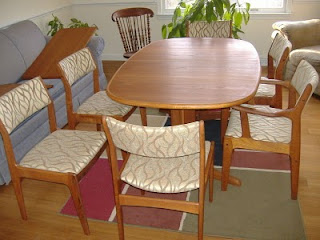
The table and 6 chairs have been returned to the owner's home.
I have thirty years of work experience with furniture repairs, antique restoration, and refinishing. I hand rub finish to get the quality of surface required of fine furnishings. I provide services for individuals in the public sector and for the moving and retail industries as well. www.thomasnelsonfurniturerestoration.com




 This walnut dining table came into the shop in late December requiring some structural alterations to fit the need of the owner. The table was built in the mid 1960's by a local amateur woodworker.We begin with cutting back the 1-1/2 inch by 6 inch frame to give clearance for the knees to move under the table. We also split the donut shape base so extensions could be added. The original set up accommodated one leaf using a slide cleat. The table and one leaf had only been finished on one side. Each top section was reconstructed to relieve as much cupping as possible. The original leaf was also cut, and then crossed cut shallow, clamped flat, and filled with epoxy resign.
This walnut dining table came into the shop in late December requiring some structural alterations to fit the need of the owner. The table was built in the mid 1960's by a local amateur woodworker.We begin with cutting back the 1-1/2 inch by 6 inch frame to give clearance for the knees to move under the table. We also split the donut shape base so extensions could be added. The original set up accommodated one leaf using a slide cleat. The table and one leaf had only been finished on one side. Each top section was reconstructed to relieve as much cupping as possible. The original leaf was also cut, and then crossed cut shallow, clamped flat, and filled with epoxy resign. ions attached and both leaves fitted, the stroke sander helped to level the top surface.
ions attached and both leaves fitted, the stroke sander helped to level the top surface.
